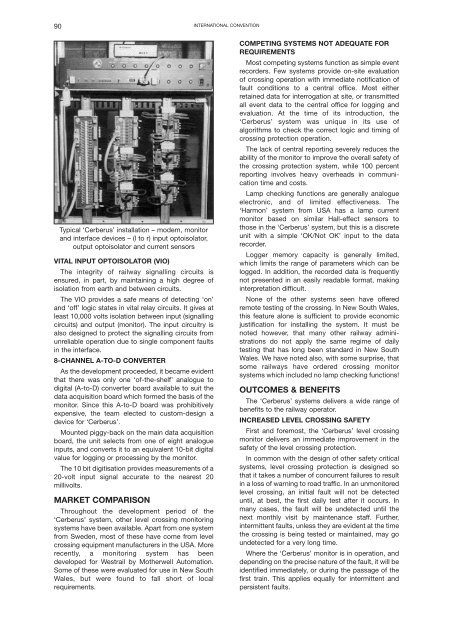Proceedings 2002/2003 - IRSE
Proceedings 2002/2003 - IRSE
Proceedings 2002/2003 - IRSE
Create successful ePaper yourself
Turn your PDF publications into a flip-book with our unique Google optimized e-Paper software.
90<br />
INTERNATIONAL CONVENTION<br />
Typical ‘Cerberus’ installation – modem, monitor<br />
and interface devices – (l to r) input optoisolator,<br />
output optoisolator and current sensors<br />
VITAL INPUT OPTOISOLATOR (VIO)<br />
The integrity of railway signalling circuits is<br />
ensured, in part, by maintaining a high degree of<br />
isolation from earth and between circuits.<br />
The VIO provides a safe means of detecting ‘on’<br />
and ‘off’ logic states in vital relay circuits. It gives at<br />
least 10,000 volts isolation between input (signalling<br />
circuits) and output (monitor). The input circuitry is<br />
also designed to protect the signalling circuits from<br />
unreliable operation due to single component faults<br />
in the interface.<br />
8-CHANNEL A-TO-D CONVERTER<br />
As the development proceeded, it became evident<br />
that there was only one ‘of-the-shelf’ analogue to<br />
digital (A-to-D) converter board available to suit the<br />
data acquisition board which formed the basis of the<br />
monitor. Since this A-to-D board was prohibitively<br />
expensive, the team elected to custom-design a<br />
device for ‘Cerberus’.<br />
Mounted piggy-back on the main data acquisition<br />
board, the unit selects from one of eight analogue<br />
inputs, and converts it to an equivalent 10-bit digital<br />
value for logging or processing by the monitor.<br />
The 10 bit digitisation provides measurements of a<br />
20-volt input signal accurate to the nearest 20<br />
millivolts.<br />
MARKET COMPARISON<br />
Throughout the development period of the<br />
‘Cerberus’ system, other level crossing monitoring<br />
systems have been available. Apart from one system<br />
from Sweden, most of these have come from level<br />
crossing equipment manufacturers in the USA. More<br />
recently, a monitoring system has been<br />
developed for Westrail by Motherwell Automation.<br />
Some of these were evaluated for use in New South<br />
Wales, but were found to fall short of local<br />
requirements.<br />
COMPETING SYSTEMS NOT ADEQUATE FOR<br />
REQUIREMENTS<br />
Most competing systems function as simple event<br />
recorders. Few systems provide on-site evaluation<br />
of crossing operation with immediate notification of<br />
fault conditions to a central office. Most either<br />
retained data for interrogation at site, or transmitted<br />
all event data to the central office for logging and<br />
evaluation. At the time of its introduction, the<br />
‘Cerberus’ system was unique in its use of<br />
algorithms to check the correct logic and timing of<br />
crossing protection operation.<br />
The lack of central reporting severely reduces the<br />
ability of the monitor to improve the overall safety of<br />
the crossing protection system, while 100 percent<br />
reporting involves heavy overheads in communication<br />
time and costs.<br />
Lamp checking functions are generally analogue<br />
electronic, and of limited effectiveness. The<br />
‘Harmon’ system from USA has a lamp current<br />
monitor based on similar Hall-effect sensors to<br />
those in the ‘Cerberus’ system, but this is a discrete<br />
unit with a simple ‘OK/Not OK’ input to the data<br />
recorder.<br />
Logger memory capacity is generally limited,<br />
which limits the range of parameters which can be<br />
logged. In addition, the recorded data is frequently<br />
not presented in an easily readable format, making<br />
interpretation difficult.<br />
None of the other systems seen have offered<br />
remote testing of the crossing. In New South Wales,<br />
this feature alone is sufficient to provide economic<br />
justification for installing the system. It must be<br />
noted however, that many other railway administrations<br />
do not apply the same regime of daily<br />
testing that has long been standard in New South<br />
Wales. We have noted also, with some surprise, that<br />
some railways have ordered crossing monitor<br />
systems which included no lamp checking functions!<br />
OUTCOMES & BENEFITS<br />
The ‘Cerberus’ systems delivers a wide range of<br />
benefits to the railway operator.<br />
INCREASED LEVEL CROSSING SAFETY<br />
First and foremost, the ‘Cerberus’ level crossing<br />
monitor delivers an immediate improvement in the<br />
safety of the level crossing protection.<br />
In common with the design of other safety critical<br />
systems, level crossing protection is designed so<br />
that it takes a number of concurrent failures to result<br />
in a loss of warning to road traffic. In an unmonitored<br />
level crossing, an initial fault will not be detected<br />
until, at best, the first daily test after it occurs. In<br />
many cases, the fault will be undetected until the<br />
next monthly visit by maintenance staff. Further,<br />
intermittent faults, unless they are evident at the time<br />
the crossing is being tested or maintained, may go<br />
undetected for a very long time.<br />
Where the ‘Cerberus’ monitor is in operation, and<br />
depending on the precise nature of the fault, it will be<br />
identified immediately, or during the passage of the<br />
first train. This applies equally for intermittent and<br />
persistent faults.

















